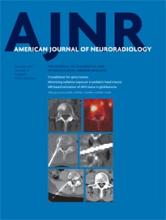Research ArticleADULT BRAIN
Open Access
On the Use of DSC-MRI for Measuring Vascular Permeability
J.T. Skinner, P.L. Moots, G.D. Ayers and C.C. Quarles
American Journal of Neuroradiology January 2016, 37 (1) 80-87; DOI: https://doi.org/10.3174/ajnr.A4478
J.T. Skinner
aFrom the Vanderbilt University Institute of Imaging Science (J.T.S., C.C.Q.)
dDepartments of Radiology and Radiological Sciences (J.T.S., C.C.Q.)
P.L. Moots
eNeurology (P.L.M.)
G.D. Ayers
fBiostatistics (G.D.A.), Vanderbilt University School of Medicine, Nashville, Tennessee.
C.C. Quarles
aFrom the Vanderbilt University Institute of Imaging Science (J.T.S., C.C.Q.)
bDepartments of Cancer Biology (C.C.Q.)
cBiomedical Engineering (C.C.Q.), Vanderbilt University, Nashville, Tennessee
dDepartments of Radiology and Radiological Sciences (J.T.S., C.C.Q.)

References
- 1.↵
- 2.↵
- Boxerman JL,
- Schmainda KM,
- Weisskoff RM
- 3.↵
- Paulson ES,
- Schmainda KM
- 4.↵
- 5.↵
- Schmainda KM,
- Prah M,
- Connelly J, et al
- 6.↵
- Paulson E,
- Prah DE,
- Schmainda KM
- 7.↵
- Weisskoff RM,
- Boxerman JL,
- Sorensen AG
- 8.↵
- 9.↵
- Quarles CC,
- Ward BD,
- Schmainda KM
- 10.↵
- Bjornerud A,
- Sorensen AG,
- Mouridsen K, et al
- 11.↵
- Emblem KE,
- Bjornerud A,
- Mouridsen K, et al
- 12.↵
- 13.↵
- 14.↵
- Uematsu H,
- Maeda M,
- Sadato N, et al
- 15.↵
- Vonken EP,
- van Osch MJ,
- Bakker CJ, et al
- 16.↵
- 17.↵
- 18.↵
- Tofts PS
- 19.↵
- Tofts PS,
- Brix G,
- Buckley DL, et al
- 20.↵
- Schmiedeskamp H,
- Andre JB,
- Straka M, et al
- 21.↵
- 22.↵
- Cha S,
- Yang L,
- Johnson G, et al
- 23.↵
- Ah-See ML,
- Makris A,
- Taylor NJ, et al
- 24.↵
- George ML,
- Dzik-Jurasz AS,
- Padhani AR, et al
- 25.↵
- Armitage PA,
- Schwindack C,
- Bastin ME, et al
- 26.↵
- Batchelor TT,
- Sorensen AG,
- di Tomaso E, et al
- 27.↵
- Toh CH,
- Wei KC,
- Chang CN, et al
- 28.↵
- Provenzale JM,
- Wang GR,
- Brenner T, et al
- 29.↵
- Donahue KM,
- Krouwer HG,
- Rand SD, et al
- 30.↵
- Bonekamp D,
- Deike K,
- Wiestler B, et al
- 31.↵
- 32.↵
- Carroll TJ,
- Rowley HA,
- Haughton VM
- 33.↵
- Newton AT,
- Skinner JT,
- Quarles CC
- 34.↵
- 35.↵
- 36.↵
- 37.↵
- 38.↵
- Mills SJ,
- Patankar TA,
- Haroon HA, et al
- 39.↵
- Liu Y,
- Ding W,
- Bensheng Q
- 40.↵
- 41.↵
In this issue
American Journal of Neuroradiology
Vol. 37, Issue 1
1 Jan 2016
Advertisement
J.T. Skinner, P.L. Moots, G.D. Ayers, C.C. Quarles
On the Use of DSC-MRI for Measuring Vascular Permeability
American Journal of Neuroradiology Jan 2016, 37 (1) 80-87; DOI: 10.3174/ajnr.A4478
0 Responses
Jump to section
Related Articles
- No related articles found.
Cited By...
- Blood-Brain Barrier Permeability and Kinetics of Inflammatory Markers in Acute Stroke Patients Treated With Thrombectomy
- Sex-specific differences in white matter microvascular integrity after ischaemic stroke
- Prognostic Predictions for Patients with Glioblastoma after Standard Treatment: Application of Contrast Leakage Information from DSC-MRI within Nonenhancing FLAIR High-Signal-Intensity Lesions
- Clinical Value of Vascular Permeability Estimates Using Dynamic Susceptibility Contrast MRI: Improved Diagnostic Performance in Distinguishing Hypervascular Primary CNS Lymphoma from Glioblastoma
This article has not yet been cited by articles in journals that are participating in Crossref Cited-by Linking.
More in this TOC Section
Similar Articles
Advertisement











